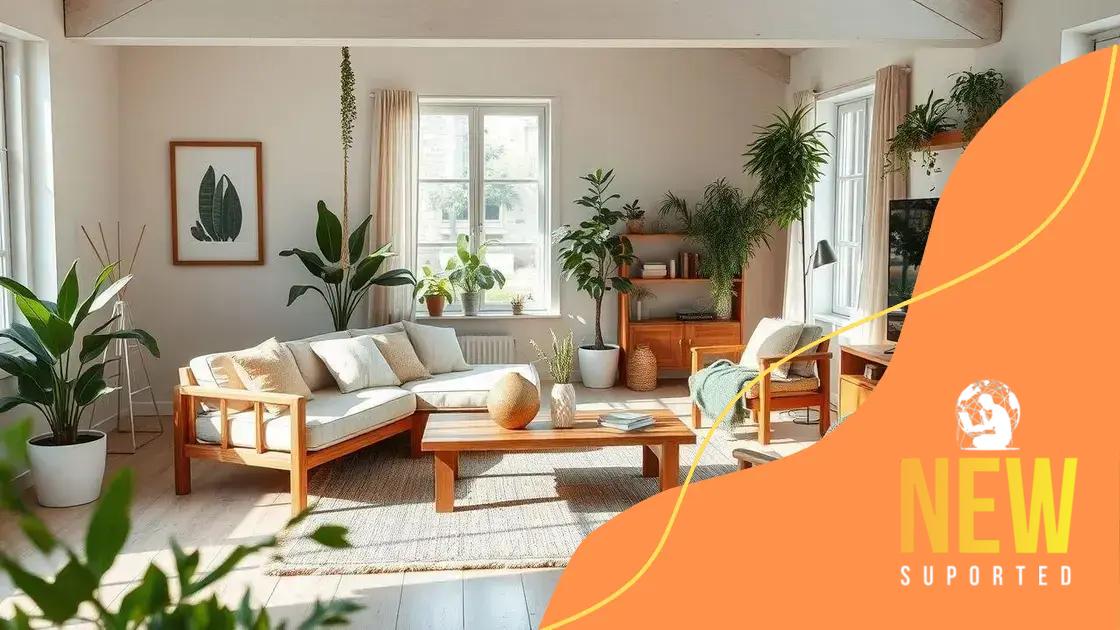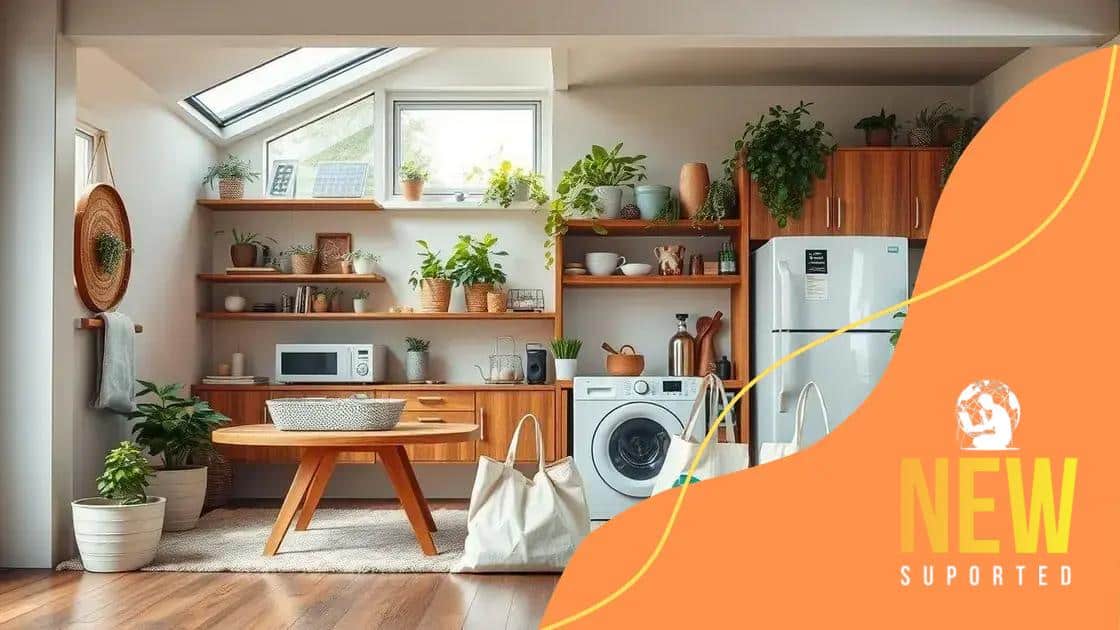Transforming your home into a haven with sustainable materials

Transforming your home into a haven with sustainable materials involves using eco-friendly options like bamboo, recycled glass, and reclaimed wood, which enhance aesthetics while promoting environmental conservation.
Transforming your home into a haven with sustainable materials not only makes your space more inviting but also promotes environmental consciousness. Have you thought about how simple changes could enhance your living experience? Let’s explore this together.
Understanding sustainable materials for home use
When it comes to building or renovating your space, understanding sustainable materials is essential. These materials not only contribute to a healthier home but also reduce your environmental footprint. Let’s explore what makes materials sustainable and how they can benefit you.
What Are Sustainable Materials?
Sustainable materials are products that have a minimal impact on the planet. They are often derived from renewable resources, require less energy to produce, and can be recycled or repurposed. This means using them in your home is not just good for you, but also for the earth.
Types of Sustainable Materials
There are various types of sustainable materials available for home use. Here are some popular options:
- Bamboo: A fast-growing grass that is strong, durable, and renewable.
- Recycled Metal: Using metal from old buildings or products helps reduce waste.
- Reclaimed Wood: This involves using wood that has been salvaged from old furniture or buildings, giving it a new life.
- Natural Stone: Materials like granite and slate not only have a long lifespan but also require minimal processing.
Choosing these materials can significantly enhance your home’s appeal while promoting sustainability. Let’s dive deeper into the benefits of using these eco-friendly options.
Benefits of Using Sustainable Materials
The benefits of incorporating sustainable materials into your home design are numerous. First, they improve indoor air quality by reducing harmful emissions. Additionally, their eco-friendly properties often mean lower energy costs due to better insulation and durability.
Moreover, using sustainable materials often adds to the aesthetic value of a space. They can lend a unique character to your home, making it feel warm and inviting. Not only do they contribute to your well-being, but they also help conserve our precious planet’s resources.
By choosing **sustainable materials**, you not only create a beautiful home but also play a part in protecting the environment for future generations. This is a win-win situation for everyone!
Benefits of using eco-friendly materials
Using eco-friendly materials in your home not only enhances its appearance but also contributes to a healthier environment. Let’s delve into the key benefits these materials can bring to your living space.
Improved Indoor Air Quality
One of the most significant advantages of using eco-friendly materials is that they can greatly improve indoor air quality. Many traditional building materials release harmful chemicals and volatile organic compounds (VOCs). In contrast, eco-friendly options are made with natural substances that emit little to no toxic fumes.
Energy Efficiency
Eco-friendly materials often provide better insulation than conventional materials. This means your home remains cooler in the summer and warmer in the winter, reducing the need for heating and cooling. As a result, you’ll notice lower energy bills!
- Natural insulation materials like wool and cellulose are excellent choices.
- Windows made from energy-efficient glass help maintain temperature.
- Solar panels made with sustainable materials can further enhance energy savings.
Not only can you save money, but you also contribute to lower energy consumption, which benefits the planet.
Durability and Longevity
Many eco-friendly materials are also more durable than their non-sustainable counterparts. For example, bamboo is not only beautiful but also incredibly strong and resistant to wear. This durability can lead to cost savings in the long run, as you won’t need to replace items as frequently.
Furthermore, these materials often have a timeless quality that keeps them in style, making your home more appealing for longer. Choosing durable and sustainable options means you’re investing in the future of your home.
Ultimately, using eco-friendly materials not only supports a sustainable lifestyle but also enhances the comfort and aesthetic of your home. By making smarter choices today, you can create a healthier environment for yourself and your family.
Practical tips for incorporating sustainability at home

Incorporating sustainability into your home can be both simple and rewarding. With a few practical tips, you can make a significant impact on the environment while enhancing your living space.
Start with Small Changes
Begin by making small changes that are easy to manage. For example, consider switching to energy-efficient light bulbs. These bulbs use less electricity and last longer than traditional options. Another simple change is to use reusable bags when shopping. This helps reduce plastic waste and is an easy step toward a more sustainable lifestyle.
Choose Eco-Friendly Products
When purchasing items for your home, look for those labeled as eco-friendly. This can include cleaning supplies, furniture, and decoration. Products made from natural, non-toxic ingredients are a great choice. They are better for your health and the planet.
- Look for certifications, such as Green Seal or Energy Star.
- Buy locally-made products to reduce carbon footprint.
- Consider second-hand items that give a new life to old products.
Adopting these habits can lead to meaningful changes, making your home not only more sustainable but also healthier.
Maximize Natural Resources
Take advantage of natural resources, such as sunlight, for your home. Install solar panels if possible, as they can save you money on energy costs while using a renewable energy source. Additionally, consider using natural ventilation by opening windows instead of relying solely on air conditioning. These practices can create a more comfortable environment while conserving energy.
Lastly, grow your own herbs or vegetables if you have space. This not only provides fresh produce but also encourages sustainability by reducing the carbon footprint associated with transporting food.
With these practical tips, incorporating sustainability into your home can be both achievable and beneficial. Every step counts towards creating a healthier planet.
Popular sustainable materials for renovation
When considering a renovation, selecting sustainable materials can make a significant difference in both aesthetics and environmental impact. Here are some popular options that can bring style while being eco-friendly.
Bamboo Flooring
Bamboo flooring is an excellent choice for its durability and renewability. Bamboo grows quickly and can be harvested without killing the plant. This makes it a highly sustainable option. In addition, bamboo has a unique look that adds warmth and elegance to any room.
Recycled Glass
Using recycled glass in countertops or decor is another fantastic way to be sustainable. This material is not only stylish but also helps reduce waste. Recycled glass products come in various colors and patterns, allowing for creativity in design while promoting eco-conscious living.
- Can be used in kitchen countertops and backsplashes.
- Offers vibrant colors and unique textures.
- Easy to clean and maintain, making it practical as well.
Integrating recycled glass into your home can enhance its beauty while keeping sustainability in mind.
Reclaimed Wood
Another popular option is reclaimed wood. This material is sourced from old structures, furniture, or flooring that would otherwise be discarded. Using reclaimed wood adds character to your home and tells a story of its past. It’s perfect for beams, flooring, and furniture.
These materials are not only sustainable but also add a unique touch to your renovation project. By choosing sustainable materials, you can create beautiful spaces that reflect your style and values while supporting the planet.
DIY projects for a sustainable home
Engaging in DIY projects can be a fun way to create a sustainable home. Not only do these projects contribute to environmental efforts, but they also allow you to express your creativity.
Upcycling Old Furniture
One of the most popular DIY projects is upcycling old furniture. Instead of throwing away chairs, tables, or dressers, consider giving them a new life. You can repaint or re-stain them to match your home’s decor. This not only reduces waste but also creates unique pieces that reflect your personality.
Creating a Vertical Garden
Another great project is starting a vertical garden. This is perfect for small spaces and can be done using recycled materials like wooden pallets or old crates. Vertical gardens allow you to grow your herbs and vegetables while maximizing space. They also improve air quality and provide fresh produce for your kitchen.
- Use pots or containers made from reclaimed materials.
- Incorporate plants that require minimal care, like succulents.
- Place your garden in an area that receives plenty of sunlight.
Creating a vertical garden is a rewarding project that enhances the beauty of your home.
Making Eco-Friendly Cleaning Products
DIY eco-friendly cleaning products are another simple and impactful project. You can create effective cleaners using natural ingredients like vinegar, baking soda, and essential oils. Not only are these alternatives safer for your family, but they also reduce reliance on harsh chemicals that are harmful to the environment.
By undertaking these DIY projects, you not only contribute to a sustainable lifestyle but also make your home more personal and unique. Every little effort counts in making a big difference!
Creating a sustainable home is an enjoyable journey that benefits both you and the planet. By incorporating sustainable materials and engaging in DIY projects, you can transform your living space into an eco-friendly haven. Remember, every small change counts! Whether it’s choosing recycled materials, growing your own plants, or making your own cleaning products, these actions contribute to a healthier environment. With creativity and a bit of effort, sustainability can become a seamless part of your lifestyle.
FAQ – Frequently Asked Questions about Creating a Sustainable Home
What are sustainable materials?
Sustainable materials are resources that have a minimal impact on the environment, often derived from renewable sources, and can be reused or recycled.
How can I start a vertical garden at home?
You can start a vertical garden using recycled materials like pallets or old crates. Plant herbs or small vegetables that thrive in limited space.
What are some eco-friendly alternatives for cleaning products?
You can make your own cleaning products using natural ingredients like vinegar, baking soda, and lemon, which are safe for both your family and the environment.
Why is upcycling important?
Upcycling helps reduce waste by giving new life to old items, which conserves resources and promotes a more sustainable lifestyle.






